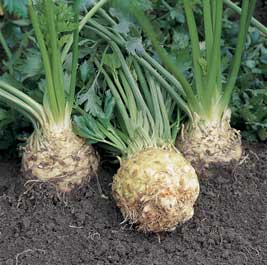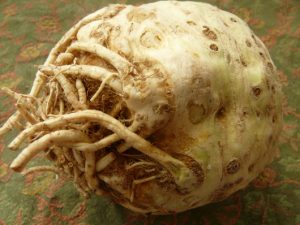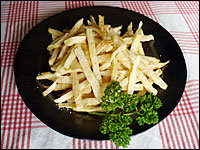Kelsey MacDonald, Seacoast Eat Local Intern
What is that funky, knobby looking vegetable at the market? It’s celeriac! Celeriac is a root vegetable, a cousin of your traditional celery. It’s leaves are not eaten, but have the delicious celery smell; a tease when weeding. Like its cousin, they both have a long growing season; celeriac takes about 112 days from seed to harvest. Its inner beauty has the starchiness of a potato with a delicate flavor of celery and parsley topped with a slight nuttiness. It is not watery like celery and is a great addition to other roasted or mashed root vegetables with some garlic. It is a great complement to many meats, makes a great stew for these cold winter days, can be fried (see recipe below) or can be eaten raw as snack sticks or in a salad or slaw. When cooked it is silky and smooth, and when raw its flesh is crispy.
Feeling adventurous and ready to try one next market? You can always find celeriac at Heron Pond Farm and sometimes other farms at the winter markets. You can pick the best one by ensuring there are no soft spots and keep in mind about one-quarter of the weight will be peeled off during preparation. You can store it in your refrigerator for two to three weeks in an unsealed produce bag. When ready to prepare it, take a thin slice off of the bottom and cut the knobbiness off of the top down to the flesh. It is best to peel the edges off using a chef or paring knife, whichever you are more comfortable with as opposed to a peeler because the skin is so thick.
So why celeriac?
Low calories and fat with only 42 calories per cup cooked.
It is a good source of fiber, vital for digestion.
Celeriac is highest in vitamin C, vitamin K, potassium, and phosphorus.
Vitamin C is an antioxidant, which helps immunity and prevents scurvy.
Vitamin K is needed for blood coagulation and calcification of bones.
Potassium is a mineral and electrolyte assisting in essential body functions.
Phosphorus is a necessary mineral for bone health.
You may not be too familiar with this unique and fun vegetable because it is not very commonly used outside of Europe and West Asia. It was commonly used in ancient European times and is most popular in France and Italy. In France, the most popular recipe is Celery Remoulade, a side dish of shredded celeriac with a mustardy mayonnaise and lemon dressing (see recipe below). Give Celeriac a try the next time you are shopping at the market!
Celery Remoulade
http://www.davidlebovitz.com/2010/04/celery-root-remoulade-celeri-rem/
- 1 cup (240 g) mayonnaise, homemade or store-bought
- 2 1/2 tablespoons Dijon mustard
- 1 teaspoon of sea salt, plus more, to taste
- 2 tablespoons freshly squeezed lemon juice
- freshly ground black pepper
- 2 1/4 pounds (1 kg) celery root
- Mix together the mayonnaise, mustard, 1 teaspoon of salt, lemon juice, and a few grinds of black pepper.
- Peel the celery root and grate it coarsely.
- Mix the dressing with the celery root and taste, adding additional salt, pepper, mustard, and lemon juice, to taste.
Note: If the salad is too thick, you can add a few spoonfuls of whole or low-fat milk to thin it out.
French Friend Celeriac
http://www.npr.org/templates/story/story.php?storyId=6551175
3 large celery roots, peeled
Juice of 1/2 lemon
3 cups vegetable oil
Salt
Juice 1/2 lemon into a big pot of water and put it on to boil.
Julienne the peeled roots by using a mandoline (a device with adjustable blades) on the French-fry setting. If you don’t have a mandoline, peel the roots, cut them into 1/4-inch slices, then into 1/4-inch sticks, and put them in a bowl of acidulated water.
Add celeriac to the pot of boiling water and blanch for 5 minutes. Drain and dry well.
In the same pot or a deep-fryer, heat the vegetable oil until smoking (about 350 degrees) and start deep frying in batches until golden. Drain on paper towels and sprinkle with salt. Reheat in the oven before serving.
Sources:
http://www.eattheseasons.com/Archive/celery_root.htm
http://www.urbanorganicgardening.org/celery-and-celeriac.html
http://www.fao.org/wairdocs/x5403e/x5403e09.htm
http://nutritiondata.self.com/facts/vegetables-and-vegetable-products/2395/2




